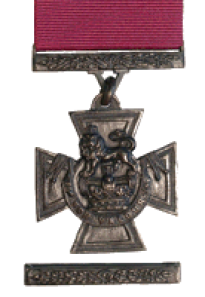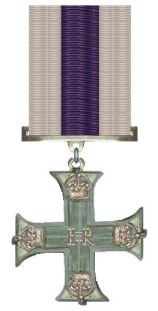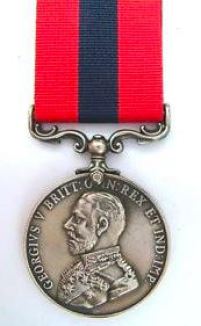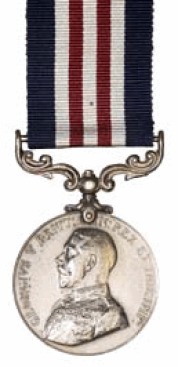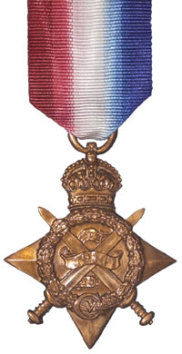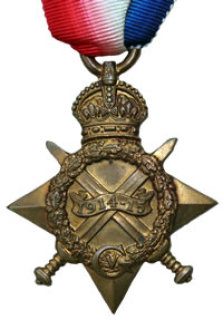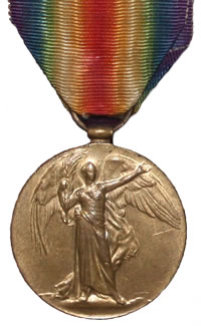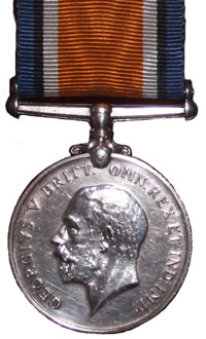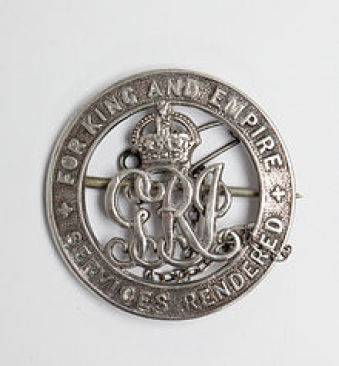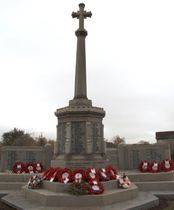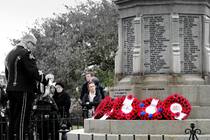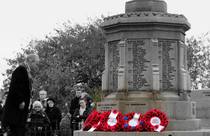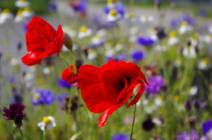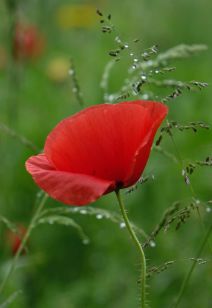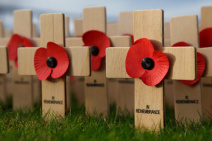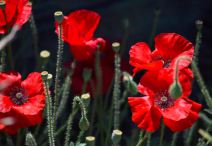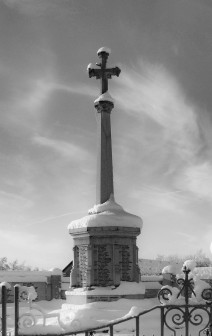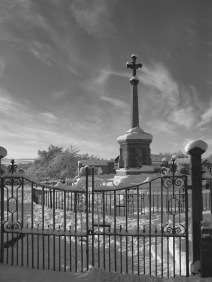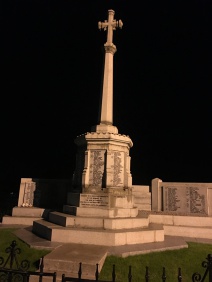Medals awarded for Service in a Theatre of War during WW1
The medal photographs below are EXAMPLES intended for illustration ONLY.
The Victoria Cross (V.C.)
The Victoria Cross (VC) is the highest award of the United Kingdom honours system.
It is awarded for gallantry "in the face of the enemy" to members of the British armed forces.
It may be awarded posthumously.
It was previously awarded to Commonwealth countries, most of which have established their own honours systems and no longer recommend British honours.
It may be awarded to a person of any military rank in any service and to civilians under military command although no civilian has received the award since 1879.
Since the first awards were presented by Queen Victoria in 1857, two thirds of all awards have been personally presented by the British monarch.
These investitures are usually held at Buckingham Palace.
The VC was introduced on 29th January 1856 by Queen Victoria to honour acts of valour during the Crimean War.
Since then, the medal has been awarded 1,358 times to 1,355 individual recipients.
Only 15 medals, 11 to members of the British Army, and four to the Australian Army, have been awarded since the Second World War.
The traditional explanation of the source of the metal from which the medals are struck is that it derives from Russian cannon captured at the Siege of Sevastopol. Some research has suggested a variety of origins for the material.
Research has established that the metal for most of the medals made since December 1914 came from two Chinese cannons that were captured from the Russians in 1855.
The Military Cross (M.C.)
The award was created on 28th December 1914 for commissioned officers of the substantive rank of Captain or below and for Warrant Officers.
In August 1916, Bars were awarded to the MC in recognition of the performance of further acts of gallantry meriting the award and recipients of a bar continue to use postnominal letters M.C.
In 1931 the award was extended to Majors and also to members of the Royal Air Force for actions on the ground.
In the 1993 review of the honours system, as part of the drive to remove distinctions of rank in awards for bravery, the MILITARY MEDAL, formerly the third-level decoration for other ranks, was discontinued.
The MILITARY CROSS now serves as the third-level award for gallantry on land for all ranks of the British Armed Forces
The Distinguished Conduct Medal (D.C.M.)
For all ranks below commissioned officers, it was the second highest award for gallantry in action after the Victoria Cross, and the Other Ranks' equivalent of the Distinguished Service Order, which was awarded to commissioned officers for bravery.
The medal could also be awarded to military personnel serving in any of the Sovereign's forces in the British Empire. It remained an exclusively Army award until 1942, when other ranks of the Royal Navy, Royal Air Force and the Navys and Air Forces of the Dominions and Colonies also became entitled to the award.
The Military Medal (M.M.)
The 1914 Star
(NOT to be confused with The 1914-15 Star (see below))
The 1914 Star (also known as The Mons Star) was a British Empire campaign medal for service in World War 1.
This medal was approved in 1917, for issue to officers and men of British Forces who served in France or Belgium between the 5th August and midnight on the 22nd/23rd November, 1914. The former date is the day after Britain's declaration of war against the central powers, and the closing date marks the end of The First Battle of Ypres.
The majority of recipients were officers and men of the pre-war British Army, specifically the British Expeditionary Force (the Old Contemptibles), who landed in France soon after the outbreak of the War and who took part in the Retreat from Mons (hence the nickname 'Mons Star').
365,622 were awarded.
Recipients of this medal also received The Victory Medal and The British War Medal. These 3 medals were sometimes irreverently referred to as Pip, Squeak and Wilfred.
The medal is a four-pointed star of bright bronze, ensigned with a crown, with a height of 50mm, and a maximum width of 45mm. The obverse has two crossed swords with blades upwards and a wreath of oak leaves, with the Royal Cypher of King George V at the foot and a central 'S'-shaped scroll inscribed 'AUG 1914 NOV.
The reverse is plain and displays the recipient's number, rank, name and unit.
The ribbon has the red, white and blue colours of the French Tri-Coloure, in shaded and waterd stripes.
A very similar medal, 'The 1914-15 Star', was also issued, but no one could receive both.
The 1914-15 Star
(NOT to be confused with The 1914 Star (see above))
The 1914-15 Star was a campaign medal of the British Empire, for service in WW1.
This medal was approved in 1918, for issue to officers and men of the British and Imperial Forces who served in any theatre of war between the 5th August 1914 and 31st December 1915 (other than those who had already qualified for The 1914 Star).
Recipients of this medal also received The Victory Medal and the British War Medal.
About 2,366,000 were awarded, including 283,500 to the Royal Navy, and 71,150 to the Canadians.
The medal was also awarded for service on the establishment of a ship or unit in a theatre of war.
A member, who had been awarded The 1914 Star, could NOT be awarded The 1914-15 Star medal.
The medal is a four-pointed star of bright bronze, ensigned with a crown, with a height of 50mm, and a maximum width of 45mm. The obverse has two crossed swords with blades upwards and a wreath of oak leaves, with the Royal Cypher of King George V at the foot and an overlaying central scroll inscribed '1914-15'.
The reverse is plain with the recipient's number, rank and name.
The ribbon has the red, white and blue colours of the Empire, in shaded and watered stripes. The same ribbon is used for The 1914 Star medal.
The Victory Medal
This medal (also called The Allied Victory Medal) is a campaign medal - of which the basic design and ribbon was adopted by Belgium, Brazil, Cuba, Czechoslovakia, France, Greece, Italy, Japan, Portugal, Romania, Siam, Union of South Africa and the USA.
The medal was issued to all those who received The 1914 Star or The 1914-15 Star, and to most of thos who were awarded The British War Medal - it was never awarded on its own. These three medal were sometime irreverently referred to as Pip, Squeak and Wilfred.
To qualify for The Victory Medal military personnel had to be mobilsed in any service and have entered a theatre of war between 5th August 1914 and 11th November 1918.
Women qualified for this and The 1914 Star or The 1914-15 Star medals, for service in Nursing Homes and other Auxiliary forces.
This medal was also awarded to members of the British Naval mission to Russia from 1919 to 1920, and for mine clearance in the North Sea between 11th November 1918 and 30th November 1919.
A member 'Mentioned In Dispatched' (MID) for service during WW1 wears a bronze oak leaf on the ribbon. Only one emblem is worn no matter how many times a mamber may have been 'mentioned'.
The Victory Medal is a 36mm diameter, circular, copper medal, and lacquered in bronze. The obverse shows the winged, full-length, full-front, figure of 'Victory', with her left arm extended and holding a plam branch in her right hand.
The reverse has the words 'THE GREAT / WAR FOR / CIVILISATION / 1914-1919' in four lines, all surrounded by a laurel wreath.
The 39mm wide ribbon has a 'two rainbow' design, with the viloet from each rainbow on the outside edges, moving through to a central red stripe where both rainbows meet.
Those personnel 'Mentioned In Dispatches' (MID) between 4th August 1914 and 10th August 1920, wear an oak leaf on the medal's ribbon.
The British War Medal
This medal was a campaign medal of the British Empire, for service in WW1.
The medal was approved in 1919, for issue to officers and men of British and Imperial Forces who had rendered service between 5th August 1914 and 11 Novenber 1918.
Officers and men of the Royal Navy, Royal Marines, and Dominion and Colonial naval forces (including Reserves) were required to have completed 28 days mobilised service - the medal was automatically awarded in the event of death on active service before the completion of this period.
The medal was later extended to cover the period 1919-20 and service in mine-clearing at sea as well as participation in operations in North and South Rusia, the eastern Baltic, Siberia, the Black Sea, and the Caspian Sea.
About 6,500,000 medal were awarded, of which 110,000 were bronze. These bronze medal were mostly issued to Chinese, Maltese, and Indians who served in Labour Battalions.
The medal is a circular, silver (or in rare cases, bronze) design. The obverse shows a King George V bare-headed effigy, facing left, with the legend GEORGIVS V BRITT : OMN : REX ET IND : IMP (George 5th, King of all the Britains, and, Emperor of India).
The reverse shows St. George, naked, on horseback armed with a short sword (an allegory of the physical and mental strength which achieves victory over Prussianism). The horse tramples on the Prussian shield, and the skull and cross-bones. Just off-centre, near the right upper rim, is the sun of 'Victory'. The dates 1914 and 1918 appear in the left and right fields respectively.
The ribbon has a wide, central, watered stripe of orange, flanked by two narrow white stripes, which are in turn flanked by two black pin-stripes, further flanked by two outer stripes of blue.
The colours are not believed to have any particular significance.
Silver War Badge (SWB)
The Silver War Badge was issued in the United Kingdom and the British Empire to service personnel who had been honourably discharged due to wounds or sickness from military service in World War I.
The badge, sometimes known as the "Discharge Badge", the "Wound Badge" or "Services Rendered Badge", was first issued in September 1916, along with an official certificate of entitlement.
The large sterling silver lapel badge was intended to be worn on civilian clothes.
The decoration was introduced as an award of the "King's silver" for having received wounds or injury during loyal war service to the Crown's authority.
A secondary causation for its introduction was that a practice had developed in the early years of the war in the United Kingdom where some women took it upon themselves to confront and publicly embarrass men of fighting age they saw in public places who were not in military uniform, by ostentatiously presenting them with white feathers, as a suggestion of cowardice.
As the war had developed substantial numbers of servicemen who had been discharged from His Majesty's Forces with wounds that rendered them unfit for war service, but which were not obvious from their outward appearance, found themselves being harassed in such a manner and the badge, to be worn on the right breast while in civilian dress, was a means of discouraging such incidents being directed at ex-forces' personnel.
It was forbidden to wear the badge on a military uniform.
The badge bears the royal cypher of "GRI" (for Georgius Rex Imperator; George, King and Emperor) and around the rim "For King and Empire - Services Rendered".
Each badge was uniquely numbered on the reverse. The War Office maintained a register recording which serviceman each one had been issued to in United Kingdom, and the governments of Canada, New Zealand, Australia, South Africa and Rhodesia maintained their own registers of issue (which were copied to the War Office in London to provide it with an Imperial master-record).
Silver War Badges issued by the Empire's dominion nations had their identification numbers on the reverse prefixed with the first letter of the issuing nation: Australia with the letter 'A', Canada 'C', etc.
In the United Kingdom the War Office made it known that it would not replace Silver War Badges if they were lost, however if one was handed into a police station then it would be returned to the War Office, which would seek to return it using its records to its recipient.
